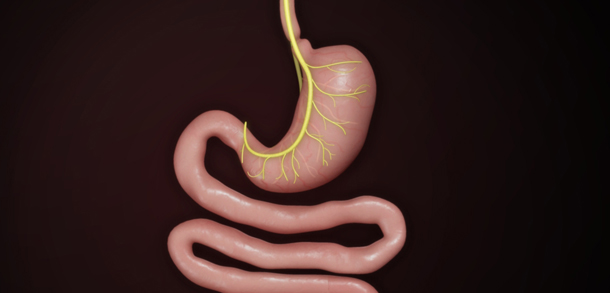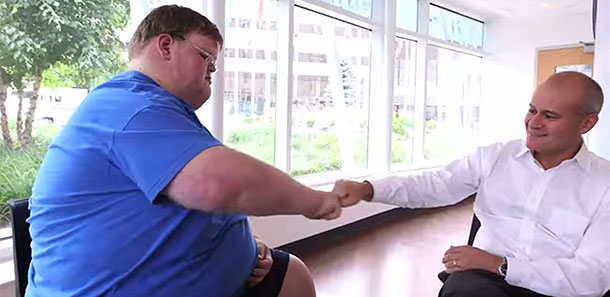Research has shown that bariatric surgery can be an effective treatment for patients with hypothalamic obesity. Dr. Inge and other physicians at Cincinnati Children’s have published reviews and their own unique findings on this topic. Dr. Inge recently wrote a blog post explaining exactly how this procedure can potentially help counteract the miscommunication between the brain and the gut, which is a trademark of hypothalamic obesity.
Patients considering this procedure might be curious about what specifically happens during the surgery. Our Surgical Weight Loss Program for Teens has a sequence of steps that they typically follow during laparoscopic gastric bypass.
For a point of reference, this is a view of the stomach before gastric bypass:

After the surgeon makes 4-5 small incisions in the patient’s belly, he or she will place a laparoscope, or small camera, through one of the cuts. Other surgical instruments will go through the remaining incisions. Here’s what happens next:
- The small intestine is divided into two sections.

The small intestine is stapled across and cut so that the lower portion (jejunum) can be reconnected to the stomach pouch (shown in step 4). - A small stomach pouch is created using a stapling device.

The surgeon will divide the stomach into two parts, and the upper, smaller portion will serve as the stomach for which all food will now enter. Typically a stomach pouch can hold about one ounce of food. The larger portion of the stomach will no longer be used. - The lower portion of the small intestine is connected to the stomach pouch.

The lower portion of the small intestine (called the jejunum) is attached to the newly created stomach pouch. This new “arm” is called the Roux limb, and it allows food to move directly from the stomach into the small intestine. It bypasses the large part of the stomach and the duodenum (the upper part of the small intestine), thereby decreasing the amount of food, nutrients, and fat that are absorbed by the body.
Dr. Inge and his team have found that patients undergoing these laparoscopic procedures have not only experienced weight loss following the surgery, but also a reduction in other associated medical issues, such as reduced insulin and early reduction in leptin levels. You can learn more about bariatric surgery at Cincinnati Children’s by visiting Surgical Weight Loss Program for Teens.
Editor’s note: The above illustrations were created by Jeff Cimprich in the Critical Care Media Lab at Cincinnati Children’s.






[…] the time, doctors recommended that Alexis undergo a vagotomy (the removal of part of the vagus nerve) and gastric bypass surgery to help her lose weight and control her appetite. The latter is often considered too dangerous for […]